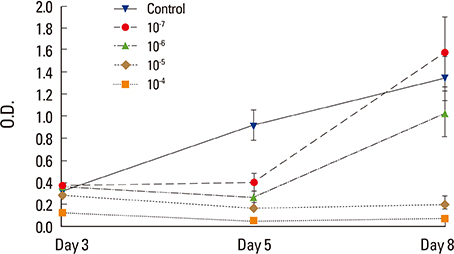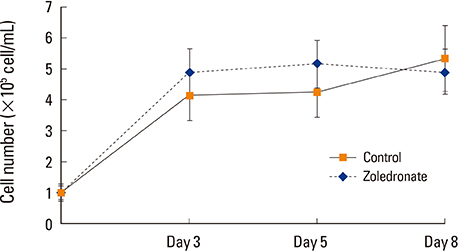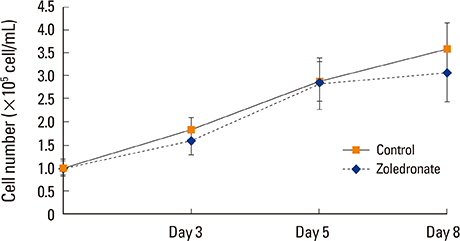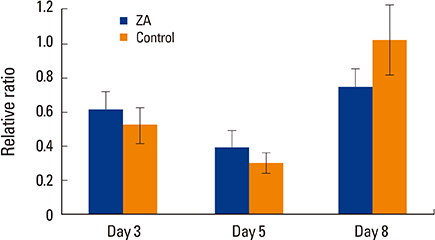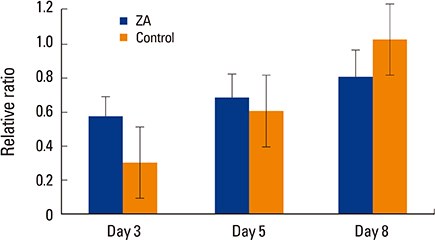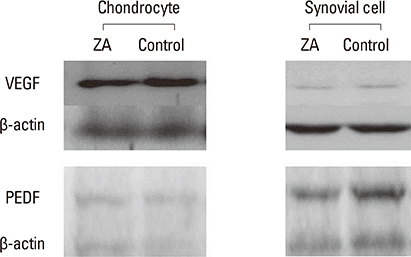J Bone Metab.
2014 Nov;21(4):249-255. 10.11005/jbm.2014.21.4.249.
Effect of Zoledronate on the Expression of Vascular Endothelial Growth Factor-A by Articular Chondrocytes and Synovial Cells: An in Vitro Study
- Affiliations
-
- 1Department of Orthopedic Surgery, Konyang University Hospital, Daejeon, Korea.
- 2Department of Orthopedic Surgery, Yonsei University Gangnam Severance Hospital, Seoul, Korea. wsleeos@yuhs.ac
- 3Department of Orthopedic Surgery, International St. Mary's Hospital, Catholic Kwandong University College of Medicine, Incheon, Korea.
- KMID: 2170052
- DOI: http://doi.org/10.11005/jbm.2014.21.4.249
Abstract
- BACKGROUND
The aim of this in vitro study was to determine the effect of zoledronate, which is frequently used to treat osteoporosis, on osteoarthritis by analyzing zoledronate-induced expression of vascular endothelial growth factor-A (VEGF-A) in chondrocytes and synovial cells.
METHODS
After chondrocytes and synovial cells were separated and cultured, zoledronate was added, and VEGF-A and pigment epithelium-derived factor (PEDF) expression were quantified by real-time polymerase chain reaction and Western blotting.
RESULTS
There was no significant difference in the expression of VEGF-A mRNA in chondrocytes between the zoledronate group and the control group on the 8th day of culture. The expression of both VEGF-A and PEDF mRNA in synovial cells was significantly decreased in the zoledronate group (P<0.05).
CONCLUSIONS
Zoledronate decreases the expression of VEGF-A in synovial cells and may affect the development and progression of osteoarthritis.
Keyword
MeSH Terms
Figure
Reference
-
1. Brandt KD, Dieppe P, Radin EL. Etiopathogenesis of osteoarthritis. Rheum Dis Clin North Am. 2008; 34:531–559.
Article2. Goldring MB, Goldring SR. Articular cartilage and subchondral bone in the pathogenesis of osteoarthritis. Ann N Y Acad Sci. 2010; 1192:230–237.
Article3. Krasnokutsky S, Attur M, Palmer G, et al. Current concepts in the pathogenesis of osteoarthritis. Osteoarthritis Cartilage. 2008; 16:Suppl 3. S1–S3.
Article4. Ashraf S, Mapp PI, Walsh DA. Contributions of angiogenesis to inflammation, joint damage, and pain in a rat model of osteoarthritis. Arthritis Rheum. 2011; 63:2700–2710.
Article5. Mapp PI, Walsh DA. Mechanisms and targets of angiogenesis and nerve growth in osteoarthritis. Nat Rev Rheumatol. 2012; 8:390–398.
Article6. Jansen H, Meffert RH, Birkenfeld F, et al. Detection of vascular endothelial growth factor (VEGF) in moderate osteoarthritis in a rabbit model. Ann Anat. 2012; 194:452–456.
Article7. Murata M, Yudoh K, Masuko K. The potential role of vascular endothelial growth factor (VEGF) in cartilage: how the angiogenic factor could be involved in the pathogenesis of osteoarthritis? Osteoarthritis Cartilage. 2008; 16:279–286.
Article8. Broadhead ML, Akiyama T, Choong PF, et al. The pathophysiological role of PEDF in bone diseases. Curr Mol Med. 2010; 10:296–301.
Article9. Fan W, Crawford R, Xiao Y. The ratio of VEGF/PEDF expression in bone marrow mesenchymal stem cells regulates neovascularization. Differentiation. 2011; 81:181–191.
Article10. Tong JP, Yao YF. Contribution of VEGF and PEDF to choroidal angiogenesis: a need for balanced expressions. Clin Biochem. 2006; 39:267–276.
Article11. Evans KD, Oberbauer AM. Alendronate inhibits VEGF expression in growth plate chondrocytes by acting on the mevalonate pathway. Open Orthop J. 2009; 3:83–88.
Article12. Kim MS, Kim JH, Lee MR, et al. Effects of alendronate on a disintegrin and metalloproteinase with thrombospondin motifs expression in the developing epiphyseal cartilage in rats. Anat Histol Embryol. 2009; 38:154–160.
Article13. Ravosa MJ, Ning J, Liu Y, et al. Bisphosphonate effects on the behaviour of oral epithelial cells and oral fibroblasts. Arch Oral Biol. 2011; 56:491–498.
Article14. Melinte R, Jung I, Georgescu L, et al. VEGF and CD31 expression in arthritic synovium and cartilage of human knee joints. Rom J Morphol Embryol. 2012; 53:911–915.15. Zhang S, Cao W, Wei K, et al. Expression of VEGF-receptors in TMJ synovium of rabbits with experimentally induced internal derangement. Br J Oral Maxillofac Surg. 2013; 51:69–73.
Article16. Pasternak B, Aspenberg P. Metalloproteinases and their inhibitors-diagnostic and therapeutic opportunities in orthopedics. Acta Orthop. 2009; 80:693–703.
Article17. Choi ST, Kim JH, Seok JY, et al. Therapeutic effect of anti-vascular endothelial growth factor receptor I antibody in the established collagen-induced arthritis mouse model. Clin Rheumatol. 2009; 28:333–337.
Article18. Sekimoto T, Hamada K, Oike Y, et al. Effect of direct angiogenesis inhibition in rheumatoid arthritis using a soluble vascular endothelial growth factor receptor 1 chimeric protein. J Rheumatol. 2002; 29:240–245.19. Di Salvatore M, Orlandi A, Bagalà C, et al. Anti-tumour and anti-angiogenetic effects of zoledronic acid on human non-small-cell lung cancer cell line. Cell Prolif. 2011; 44:139–146.
Article20. Osterman T, Kippo K, Laurén L, et al. Effect of clodronate on established adjuvant arthritis. Rheumatol Int. 1994; 14:139–147.
Article21. Le Goff B, Heymann D. Pharmacodynamics of bisphosphonates in arthritis. Expert Rev Clin Pharmacol. 2011; 4:633–641.
Article22. Kang JH, Choi NK, Kang SJ, et al. Alendronate affects cartilage resorption by regulating vascular endothelial growth factor expression in rats. Anat Rec (Hoboken). 2010; 293:786–793.
Article23. Van Offel JF, Schuerwegh AJ, Bridts CH, et al. Effect of bisphosphonates on viability, proliferation, and dexamethasone-induced apoptosis of articular chondrocytes. Ann Rheum Dis. 2002; 61:925–928.
Article
- Full Text Links
- Actions
-
Cited
- CITED
-
- Close
- Share
- Similar articles
-
- Expression Of Igf-1 And Tgf-beta In Rheumatoid Arthritis And O~teoarthritis
- Expression of Vascular Endothelial Growth Factor in an Animal Model of Avascular Necrosis of the Femoral Head
- Transforming growth factor-beta 1 responsiveness of human articular chondrocytes in vitro: normal versus osteoarthritis
- The Expression of Extracellular Matrix mRNA in the Chondrocytes of the Femoral Head Affected by Avascular Necrosis
- Expression of Vascular Endothelial Growth Factor in Diabetic Frozen shoulder

